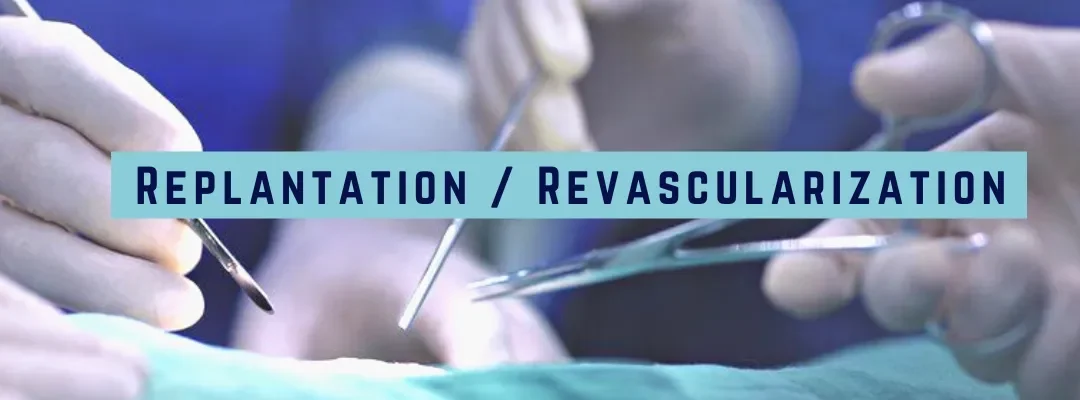The goal of replantation (commonly known as re-implantation or re-attachment surgery) after traumatic amputation is successful attachment and restoration of circulation in the severed body part thereby restoring its form and function.
The severed body part when replanted, the restored circulation will facilitate healing of all severed tissues including bony union, tendon healing and nerve regeneration resulting in a sensate, painless, normal looking and usable body part.
Scope:
With advent and advancement in microsurgical techniques, successful replantations of even terminal part of fingers is now a reality. Replantation of amputated parts can be done for amputated fingers, hands, forearms, feet, amputated ears, avulsed scalp injuries, an amputated face, amputated lips, amputated penis and even in an amputated tongue.
Cause of Amputations:
These injuries can arise from multiple potential etiologies including trauma (often industrial), machine injuries, assault or even self-mutilation. We will focus on finger and upper extremity replantation here since they are much more common than other amputations.
Indications:
The indications and contraindications are not absolute, and the decision for replantation is best made by the patient and physician after a discussion of the potential outcome, benefits, risks, possible complications and available alternatives to the replantation. This discussion is very dependent on the surgeons judgement of the potential outcome in a given patient which at times can be best done in the operation theatre under good light and magnification. If the patient does not want to undergo replantations, then the surgeon will discuss other treatment options to heal the wound.
Indications:
- Any level of upper limb amputation/s
- Lower limb amputation at any level below the knee
- Scalp avulsion- where the entire hair bearing scalp is pulled off from the head
- Penis amputation
- Ear/ tongue amputation
Contraindications:
When is a patient not a good candidate for replantation-
- Medical co-morbidities that can affect anesthesia and long surgery
- Life threatening injuries
- Refusal to accept blood transfusions or blood products
Decision making in replantations:
The following factors need to be considered:
- History about time since injury, mode of amputation, other injuries and transport of amputated part to the hospital.
- Physical examination: An examination of the amputated part(s) and of course the affected limb is required to understand the extent of injury and potential for success and useful functional outcome.
- Medical co-morbidities
- Occupation
- Hand dominance: in case of hand or finger amputations
An examination of the amputated part(s) and of course the affected limb is required to understand the extent of injury and potential for success and useful functional outcome.
The feasibility of replantation may not be certain on gross inspection and may not be apparent until after surgical dissection intraoperatively. A radiographic evaluation is invaluable for the assessment of the extent of bone injury and or loss of bone.
Surgical Procedure:
The amputated part is aseptically prepped and surgically exposed/tagged under loupe magnification. The following are the steps involved in replantations surgery:
- Identification of cut structures in the amputated part and the body.
- Bone shortening and fixation
- Flexor tendon/muscle repair.
- Extensor tendon/muscle repair
- Nerve repair.
- Arterial repair (with vein grafts if necessary).
- Venous repair (with vein grafts if necessary).
- Skin grafting or local flap if necessary.
- Microvascular free tissue transfer/ free flap if necessary
- Bone fixation: shortening is done so the cut structures can be got together easily for repair.
- Fixation is done wither using wires, internal plates or external fixation system.
- Tendon repair: tendons in front and back of the hand need to be repaired to get movements of the attached finger.
- Nerve repair: nerve ends are freshened and repaired under microscope.
- Arterial repair: this is the most important step in a replant surgery. The cut ends of artery are joined with sutures and once this is complete, the finger or hand should become pink which is sign of restoration of circulation.
- Veins on the back of the hands or finger are then joined.
- Skin closure is completed.
- Plaster is applied
Post surgery Case:
Patients are monitored for perfusion disturbances in the replanted part. Monitoring is performed by the nursing staff and microsurgical team. Any change in perfusion is addressed according to the etiology of the disturbance. Treatment may be as simple as removal of restrictive dressings or repositioning a patient to promote venous drainage.
Medical management of perfusion with anti-coagulants can be changed according to the patient’s response, especially with medicinal leeches and heparin. Operative re-exploration may be required at times.
During hospitalization, consultation with an occupational therapist is initiated. Post-operative therapy is critical to success, and a patient that does not put full effort into this rehabilitation is very likely to do poorly. Therapy is continued with an outpatient program after discharge
Duration of hospital stay:
8-10 days
Rehabilitation:
Once there are signs of bony union after 4-6 weeks, therapy is begun to restore movements at all joints.
Conclusion:
Replantations is the most gratifying surgery in Microsurgery.
When you save a patient’s life, you keep him alive…
When you save a patient’s limb, you help him survive

